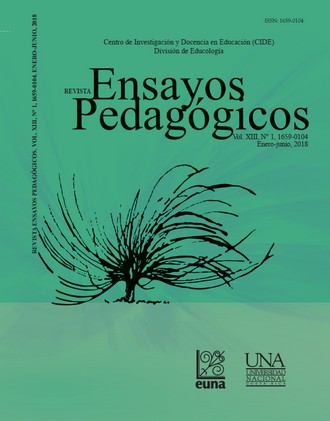Efecto del programa “Un paso activo” en los hábitos de movimiento de estudiantes de primaria
DOI:
https://doi.org/10.15359/rep.13-1.3Palabras clave:
intervención, cambio conducta, actitud, actividad físicaResumen
El propósito de este artículo es evaluar el efecto de la propuesta Un paso activo en los hábitos de movimiento de estudiantes. Sujetos: 69 estudiantes de tercer grado de una escuela urbana pública del cantón central de San José, de los cuales 34 pertenecieron al grupo experimental (16 niños y 18 niñas) y 35 al grupo control (15 niños y 16 niñas), con edades promedio de 9.2 años, tomaron parte en el estudio. La intervención utilizó el acercamiento socio-constructivista de las lecciones de educación dado por el MEP en la organización de las lecciones de Educación Física. Diseño del estudio: Cuasiexperimental a través de 4 meses. Resultados: Los niños y niñas en el grupo experimental tuvieron un incremento significativo en el conocimiento, y en el tiempo reportado en actividad física a través del reporte dirigido (<.05). Se presentó un efecto positivo en el cambio de actitud hacia la actividad física de las mujeres del grupo experimental. Conclusiones: La estrategia pedagógica dada por el MEP, mejoró el tiempo dedicado a la actividad física y el estado de cambio de los participantes en el grupo experimental, especialmente en las niñas.Referencias
Álvarez, C. (2016). Efectividad del programa ecológico “Saltando por su salud” en la promoción de la actividad física y la auto-eficacia en niños y niñas escolares de tercer grado. Revista Ensayos pedagógicos, 11(1), 147-169.
Bandura, A. (1977). Self-efficacy: The exercise of control. New York: Freeman.
Biddle, S. J. H., O’Connell, S., y Braithwaite, R. E. (2011). Sedentary behaviour interventions in young people: A meta-analysis. British Journal of Sports Medicine, 45(11), 937–942.
Bronfenbrenner, U. (1979). The Ecology of Human Development: Experiments by Nature and Design. Harvard University Press,Cambridge, MA.
Camacho-Min, M., Nicole M., LaVoi Daheia J, y Barr-Anderson. (2011). Interventions to promote physical activity among young and adolescent girls: a systematic review. Health Education Research, 26(6),1025-49.
Center for Disease Control and Prevention [CDC]. (2013). Make a Difference at Your School. Recuperado de http://digitalcommons.hsc.unt.edu/cgi
Cox, M., Schofield, G., y Kolt, G. S. (2010). Responsibility for children’s physical activity: parental, child, and teacher perspectives. J. Sci. Med. Sport, 13, 46–52.
Demetrious, Y., y Höner, O. (2012). Physical activity interventions in the school setting: A systematic review. Psychology of Sport and Exercise, 13(2), 186–196.
Dudley, D., Okely, A., Pearson, P., y Cotton,W., (2011). A systematic review of the effectiveness of physical education and school sport interventions targeting physical activity, movement skills and enjoyment of physical activity. Eur. Phys. Educ. Rev, 17, 353–378.
Greaves, C., Sheppard, K., Abraham, C., Hardeman, W., Roden, M., Evans, P., y Schwarz, P. (2011). Systematic review of reviews of intervention components associated with increased effectiveness in dietary and physical activity interventions. Bio-Med, 11, 2-12.
Gorely, T, y Bruce, D. (2000). A 6-month investigation of exercise adoption from the contemplation stage of the transtheoretical model. Psychology of Sport and Exercise,1(2), 89-101.
Haas, S y Nigg C. (2008). Construct validation of the stages of change with strenuous, moderate, and mild physical activity and sedentary behaviour among children. Journal of Science and Medicine in Sport, 12, 86–591.
Harrell, S., Gansky, S., McMurray, R., Frauman, A., y Bradley, C. (1998). School based interventions improve heart health in children with multiple cardiovascular disease risk factors. Pediatrics, 102, 371-380.
Hynynena, S.,M. M. van Stralenb, F. F. Sniehottac, V. Araújo-Soaresc, W. Hardemand, M. J. M. Chinapawe, T. Vasankarif y. Hankonena. (2015). A systematic review of school based interventions targeting physical activity and sedentary behaviour among older Adolescents. International Review Of Sport And Exercise Psychology, 9(1), 22–44. http://dx.doi.org/10.1080/1750984X.2015.1081706
Janssen, I., y LeBlanc, A. G. (2010). Review systematic review of the health benefits of physical activity and fitness in school-aged children and youth. International Journal of Behavioral Nutrition and Physical Activity, 7(40), 1–16.
Janz K. F., Burns T. L., y Levy, S. M. (2005). Tracking of Activity and Sedentary Behaviors in Childhood: The Iowa Bone Development Study. Am J Prev Med, 29(3), 171–178.
Kahn, E. B., Ramsey, L. T., Brownson, R. C., Heath, G. W., Howze, E. H., Powell, K. E., Stone, E. J., Rajab, M. W., y Corso, P. (2002). The effectiveness of interventions to increase physical activity: a systematic review. Am J Prev Med, 22, 73–107.
Kowalski, K., Crocker, P., y Faulkner, R. (1997). Validation of the Physical Activity Questionnaire for Older Children. Pediatric Exercise Science, 174-186.
Lox, C., Martín, K. y Petruzzello, S. (2006). The Psychology of Exercise. Arizona: HHP.
Lubans, D. R., Foster, C., y Biddle, S. J. H. (2008). A reviewofmediators of behavior in interventions to promote physical activity among children and adolescents. Prev. Med, 47, 463–470. 20.
McKenzie, T. L., Nader, P. R., Strikmiller, P. K., Yang, M. (1996). School physical education: Effectof the child and adolescent trial for cardiovascular health. Prev.Med, 25, 423–431.
Marcus, B. y Forsyth, L.(2003). Motivating People to be Physical Active. Champaign, IL: Human Kinetics.
MEP. (2013). Programas de Estudio de Educación Física. San José, Costa Rica: Autor.
Michie, S., y Abraham, C. (2004). Interventions to change health behaviours: evidencebased or evidence-inspired? Psychol. Health, 19, 29–49.
Nader, P., Sellers, D., Johnson, C., Perry ,C., Stone, E., Cook, K., Bebchuk, J, and Luepker, R. (1996). The effect of adult participation in a school-based family intervention to improve Children's diet and physical activity: the Child and Adolescent Trial for Cardiovascular Health. Revista end línea Pub-Med, 25(4),455-64. Recuperado de https://www.ncbi.nlm.nih.gov/pubmed/8818068
Peters, L. W., Kok, G., Ten Dam, G., Buijs, G. J., y Paulussen, T. (2009). Effective elements of school health promotion across behavioral domains: A systematic review of reviews. BMC Public Health, 9(1), 182–196.
Prochaska, J. y DiClemente, C. (1983). The Transtheoretical Model. Recuperado de http://ocw.unican.es/ciencias-de-la-salud/promocion-de-la-salud/material-de-clase/tema-3.-el-modelo-transteorico/skinless_view
Safron, D, Schulenberg, J y Bachman, J (2001). Part-time work and hurried adolescence: The links among work intensity, social activities, health behaviors, and substance use. Journal of Health and Social Behavior, 42, 425–449. 10.2307.3090188. [PubMed].
Sallis, J., McKenzie, T. L., Alcaraz, J., Kolody, B., Faucette, N., y Hovell, M. (1997). The effects of a 2-year physical education program (SPARK) on physical activity and fitness in in elementary school students. Sports, Play and Active Recreation for Kids. Am J Public Health, 87(8), 1328-34.
Salmon, J., Booth, M. L., Phongsavan, P., Murphy, N., y Timperio, A. (2007). Promoting Physical Activity Participation among Children and Adolescents. Epidemiol Rev, 29, 144–159. 23.
Salmon, J., y Timperio, A. (2007). Prevalence, trends and environmental influences on child and youth physical activity. Med Sport Sci, 50, 183-199. 15.
Thorp, A., Owen, N., Neuhaus, M, y Dunstan, D. (2011). Sedentary behaviors and subsequent health outcomes in adults a systematic review of longitudinal studies. American Journal of Preventive Medicine, 41(2), 207-215.
Timperio, A., Salmon, J., y Ball, K. (2004). Evidence-based strategies to promote physical activity among children, adolescents and young adults: review and update. Journal of Science and Medicine in Sport, 7(Suppl 1), 20–29.
Van Sluijs, E., Van Poppel, M., Stalman, W., y Van Mechelen, W. (2004). Feasibility and acceptability of a physical activity promotion program in general practice. Family Practice, 21, 429–436.
Walter, H., Hofman, A., Connelly, P., Barrett, L, y Kost, K. (1985). Primary prevention of chronic disease in childhood: changes in risk factors after one year of intervention. Am J Epidemiol, 122, 772-81.
Ward, D., Saunders, R., y Pate, R. (2007). Physical Activity Interventions in Children and Adolescents. Champaign, Il: Human Kinetics Publishers.
Weston, A., Petosa, R., y Pate, R. (1997). Validation of an instrument for measurement for physical activity in youth. Medicine and Science in Sport and Exercise, 29, 138-143.
WHO. (2010). Recomendaciones mundiales sobre actividad física. Ginebra, Suiza: OMS.
Wilmot, E. G., Edwardson., C. L., Achana, F. A., Davies, M. J., Gorely, T., Gray, L. J, y Biddle, S. J. H. (2012). Sedentary time in adults and the association with diabetes, cardiovascular disease and death: Systematic review and meta-analysis. Diabetologia, 55, 2895–2905.
Descargas
Publicado
Cómo citar
Número
Sección
Licencia
La Revista Ensayos Pedagógicos está suscrita a la Licencia Creative Commons Atribución-NoComercial-SinDerivadas 4.0 Internacional, lo cual implica la posibilidad de que tanto las personas autoras como las personas lectoras puedan, de forma gratuita, descargar, almacenar, copiar y distribuir la versión final aprobada y publicada (post print) del artículo, siempre y cuando se realice sin fines comerciales, no se generen obras derivadas y se mencione la fuente y autoría de la obra. Asimismo, la Revista Ensayos Pedagógicos declara que toda persona autora conservará a perpetuidad los derechos de autoría de su ensayo o artículo.









